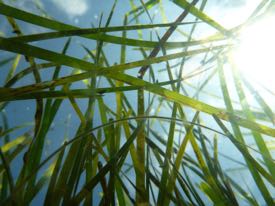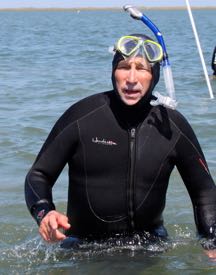Return of bay grasses is sentinel for Chesapeake Bay recovery
National Academy of Sciences study shows that nutrient and stormwater reductions have improved Bay health
A research article in the most recent issue of the Proceedings of the National Academy of Sciences ties long-term nutrient reductions in Chesapeake Bay to a resurgence of underwater grasses, one of the Bay’s most important nursery habitats and feeding grounds. The findings support continued nutrient reductions via conservation incentives and the Environmental Protection Agency’s Total Maximum Daily Load.
Dr. Jonathan Lefcheck and 13 co-authors show that a 23 percent reduction in average nitrogen levels in the Bay and an 8 percent reduction in average phosphorus levels have led to a 4-fold increase in the abundance of submerged aquatic vegetation (SAV). This ecosystem recovery is the largest resurgence of underwater grasses ever recorded.
 “It’s a humbling and unique opportunity,” says Lefcheck, formerly of William & Mary’s Virginia Institute of Marine Science and now at the Bigelow Laboratory for Ocean Science. “These efforts began before I was even born, but we are at a stage now where all these different threads can be pulled together to unveil a picture of unprecedented success. This is a message of hope, and I look forward to a future when the Bay is filled with grasses, something I never thought I would see during my lifetime."
“It’s a humbling and unique opportunity,” says Lefcheck, formerly of William & Mary’s Virginia Institute of Marine Science and now at the Bigelow Laboratory for Ocean Science. “These efforts began before I was even born, but we are at a stage now where all these different threads can be pulled together to unveil a picture of unprecedented success. This is a message of hope, and I look forward to a future when the Bay is filled with grasses, something I never thought I would see during my lifetime."
The researchers employed advanced analytical tools to show how reduction of excess pollutants such as nitrogen and phosphorus is the cause of the ecosystem recovery. To link land use and Chesapeake Bay status, they analyzed data in two different ways: one focusing on the cascade of nutrients from the land to water, and one showing what happens to SAV once the nutrients are in the water.
The findings are a collaborative effort between researchers at VIMS, the University of Maryland Center for Environmental Science (UMCES), the Environmental Protection Agency’s Chesapeake Bay Program, the U.S. Geological Survey, the National Socio-Environmental Synthesis Center, St. Mary’s College of Maryland, the Smithsonian Environmental Research Center, the Maryland Department of Natural Resources, and Texas A&M University-Corpus Christi.
The report’s senior co-authors, Drs. Robert “JJ” Orth of VIMS and William Dennison of UMCES, have worked for decades on underwater grasses and water-quality reporting for Bay ecosystem restoration. Orth received the outstanding scientist of Virginia award March 1 from Governor Ralph Northam. Dennison is the recipient of the first Margaret A. Davidson Award for Stewardship from the Coastal Estuarine Research Federation.
 Says Orth, “I’m proud of our team of young and experienced researchers who worked in a collaborative environment to produce these exciting results. I really feel the torch is being passed to a next generation of scientists who bring both the passion and knowledge needed to continue the vital work of marine science required to keep our Bay flourishing. What has been a lifetime of work for Bill and me can now be managed with creative analyses of long-term data sets to highlight this wonderful recovery."
Says Orth, “I’m proud of our team of young and experienced researchers who worked in a collaborative environment to produce these exciting results. I really feel the torch is being passed to a next generation of scientists who bring both the passion and knowledge needed to continue the vital work of marine science required to keep our Bay flourishing. What has been a lifetime of work for Bill and me can now be managed with creative analyses of long-term data sets to highlight this wonderful recovery."
"J.J. and I have had the distinct privilege of facilitating research that confirms a direct correlation between conservation actions undertaken by a broad partnership and ecosystem responsiveness that is leading to positive ecological outcomes,” says Dennison. “The EPA Chesapeake Bay Program is working and can serve as a model for the rest of the world."
The article is now available through the Proceedings of the National Academy of Sciences.

